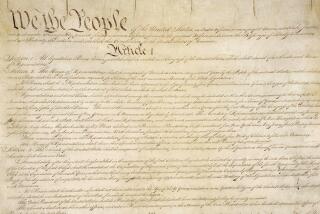. . . For a Living Document
The bicentennial of the Constitution focuses renewed attention on the nation’s Founding Fathers at a time when it is argued that we are now bound by what they intended two centuries ago. The so-called doctrine of “original intent,” much loved by the Reagan Administration and its friends, says that the way to proper constitutional interpretation is through historical research: Find out what the Founding Fathers meant and implement it.
This sounds like a good idea, but it is flawed for practical as well as for philosophical reasons. In the first place, finding out what the framers meant is no easy task. Though several of the participants at the constitutional convention took notes--the most extensive were by James Madison--they do not always make clear what the framers had in mind. Further, they show that the nation’s founding was marked by tremendous disagreement and debate. Much of what is in the Constitution resulted from compromising opposing views.
For example, how long should the term be for members of the House of Representatives? One group favored three years on the ground that it would take that long for the elected representatives from one state to learn the problems of the whole country. The other side favored one-year terms for members of the House on the ground that frequent elections would keep the representatives close to the will of the people and prevent tyranny, which was much on the minds of people who had just gotten rid of a king by force of arms. The solution: two-year terms for the House. What was the framers’ original intent?
There was so much disagreement about the final document that Edmund Randolph, the governor of Virginia, who brought a draft to Philadelphia of what became the Constitution, refused to sign it when the convention rose.
And why limit original intent to the original intent of the framers themselves? What about the original intent of the ratifiers? The debates of the constitutional conventional were replayed in each state, and the ratifications of the new Constitution did not go smoothly. The Federalist Papers come down to us as the prime contemporary statement of the Constitution’s meaning. But there were also Antifederalist papers that saw things differently. The country was divided. The ratifying convention in Virginia voted in favor of the Constitution by 89 to 79. New York voted for the new government by a mere 30 to 27.
Finally, even in its own time, people recognized that they were not bound by the “original intent” of the Founding Fathers. In 1803, when the U.S. Supreme Court decided the great case of Marbury vs. Madison (Madison by then was secretary of state), Chief Justice John Marshall declared a law of Congress unconstitutional. That law, the Judiciary Act of 1789, had been passed by a Congress whose members included delegates to the constitutional convention. It had been signed into law by President George Washington, who had presided over the convention in Philadelphia. If they didn’t know what the original intent of the framers was, who does?
As usual, John Marshall had it right. The genius of the Constitution is that it is a living document. It remains as vital today for the government of the world’s most developed and most powerful country as it was for 13 rural states 200 years ago. The world has changed much since those 55 men sweltered through that summer in Philadelphia creating a government from whole cloth. Through it all, their basic ideal of liberty endures. The details are left to each generation to work out.
More to Read
Get the L.A. Times Politics newsletter
Deeply reported insights into legislation, politics and policy from Sacramento, Washington and beyond. In your inbox three times per week.
You may occasionally receive promotional content from the Los Angeles Times.










